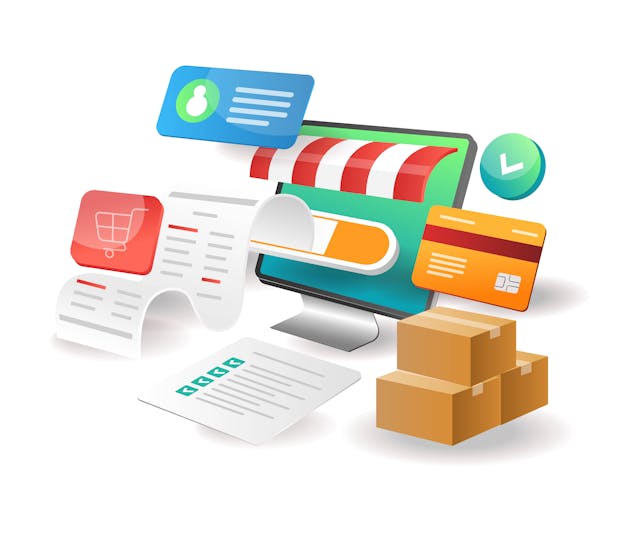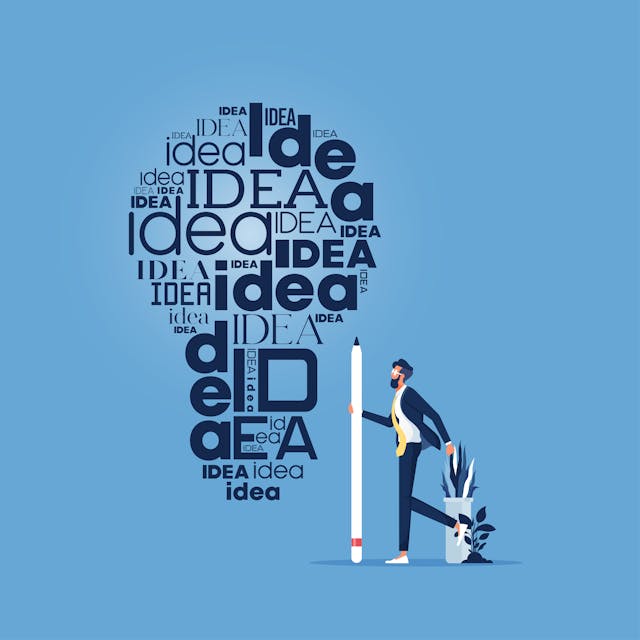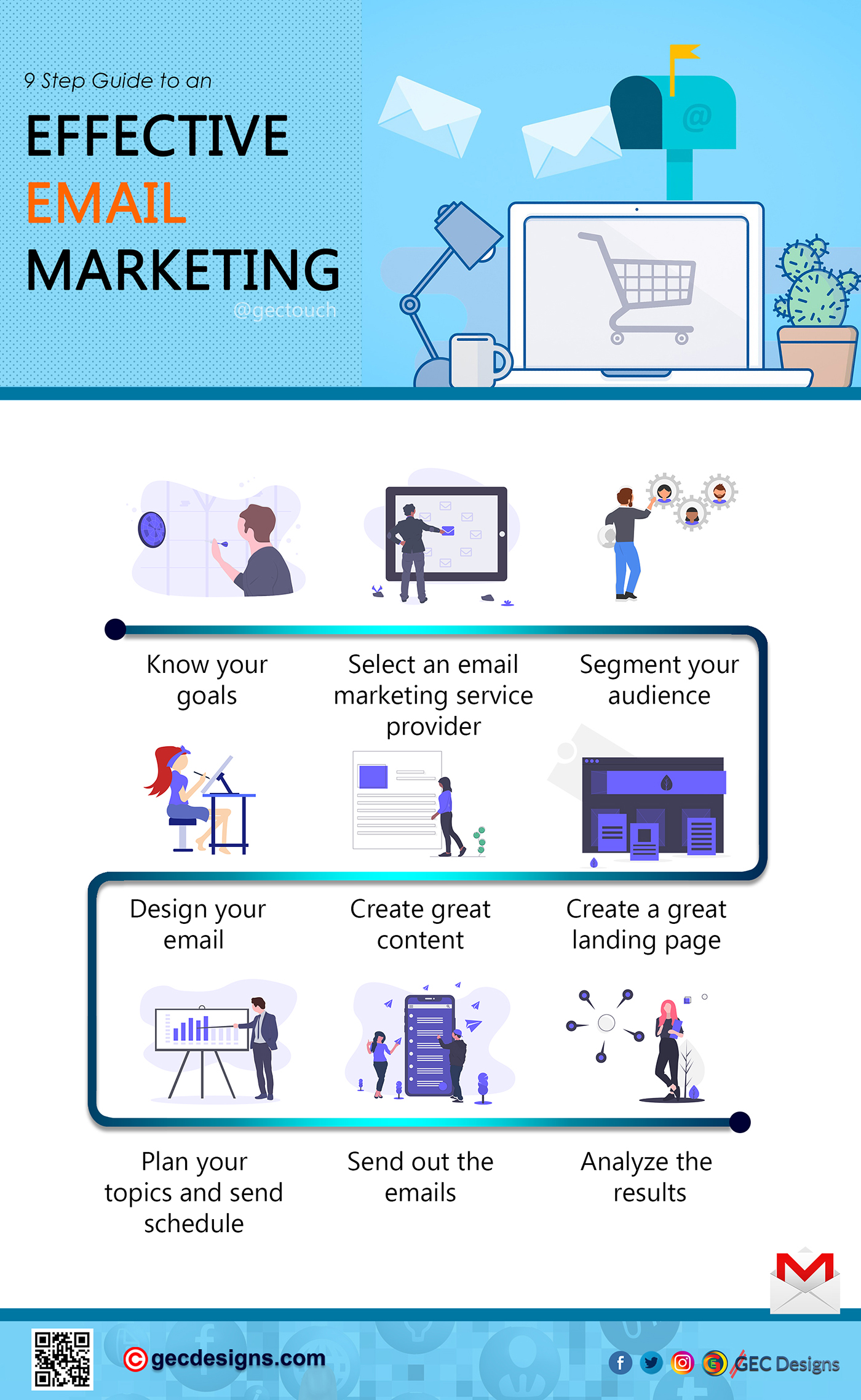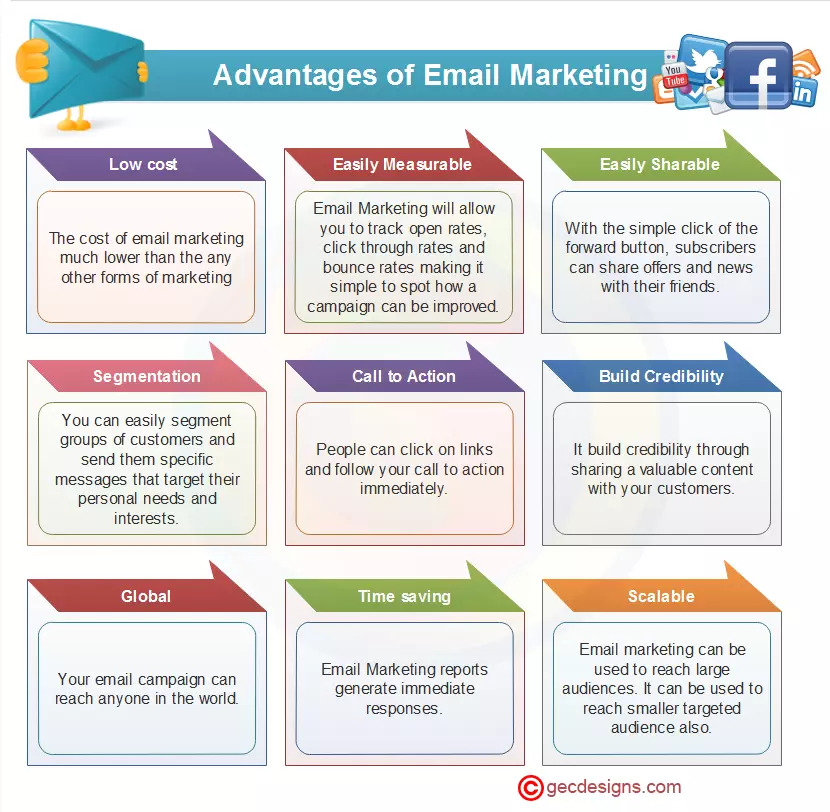9 Step Guide to an Effective Email Marketing campaign
How does Email Marketing work?
Email marketing is known as the promotion of a product or service by sending commercial messages to targeting people via email. Every email sent to a potential or current customer could be considered as email marketing. Email marketing is also known as direct mail marketing. It is one of the segments of internet marketing. Email marketing is a popular way for businesses to reach customers. It is one of the fastest, cheapest, and easiest ways for marketers to connect with customers. It usually involves using email to send advertisements, request business, and donations.
The purpose of email marketing is to enhance the relationship of a merchant with customers, convincing current customers to purchase something immediately, capturing new customers, and to encourage customer loyalty. It is meant to build trust and brand awareness.
In this article, you can learn what email marketing really is? why companies should use email marketing? and the 9 steps to implement your email marketing strategy.
Types of effective marketing emails
- Transactional Emails
- Email newsletters
Transactional Emails
Transactional email is an automatic email system. Transactional emails may also be called triggered emails. They are triggered by user interaction, these emails are sent to one person, rather than too many people at a time. For example, when a customer buys a product or makes a reservation, emails are sent out to confirm that transaction. Transactional emails are an opportunity to introduce or extend the email relationship with customers.
These emails include,
- Welcome emails
- Account creation emails
- Password reset emails
- Order confirmation emails
- Thank you emails
- Order status emails
- Reorder emails
- Purchase Receipt emails
- Account balance updates
- Review request emails
Email newsletters
The email newsletter is one of the most effective types of email marketing strategy. An email newsletter is a message that is sent out to customers at a regular interval. It may be sent daily, weekly, monthly or annually. Newsletter emails inform customers of current promotions, sales, and the newest offering.
Newsletters usually don't have explicit sales messages. It informs users about your products and it tells them what you have been up to and it helps you to build a unique relationship with your customers. It creates awareness of your company, product, or brand. It drives page views to your website as well.
Types of content in email newsletters are
- Articles about your industry
- Letter from the CEO or other executive
- Product testimonials
- Success stories or customer spotlights
- Educational articles
- Links to useful sections of your website
- Question and answer columns
- Special offers or coupons
- Opinion columns from experts
- Tips and advice columns
- Product reviews and announcements of new products
- Upcoming events calendars
- Contest announcements
- Featured quotes
- Surveys, polls, and feedback
9 Step Guide to an effective Email Marketing
- Know your goals
- Select an email marketing service provider
- Segment your audience
- Design your email
- Create great content
- Create a great landing page
- Plan your topics and send schedule
- Send out the emails
- Analyze the results
Email marketing is known as the promotion of a product or service by sending commercial messages to the targeted people via email.
Let us see each of these steps in detail,
1. Know your goals
Before you start, it is important to plan your email marketing strategy. Email marketing helps you to stay focused and motivated all the time. Identify what the main aim of your email campaign is. If you haven’t determined the objective of your campaign, you cannot proceed with further steps in the email marketing process.
The email marketing processes include,
- Welcoming new customers
- Build a relationship with them
- Increase your brand’s visibility
- Build customer loyalty
- Launch a new product
- Promote a specific product
- Generate conversions or sales
- Increase website traffic
2. Select an email marketing service provider
Email marketing service providers can help you in creating successful email marketing campaigns. There is a huge range of email marketing tools available. Important thing is to choose one that fits your aim and your budget. Look for free trials so you can review the product before buying it. Email marketing service providers will help you to schedule transactional emails, respond quickly to customers, create and deliver promotional emails.
Some of the most popular email marketing service providers are,
3. Segment your audience
You need to decide who you are going to contact (defining the target audience). To make your email content relevant, you need to identify your target audience. Segment your email list for better targeting. You will be able to segment it based on your audience on the basis of their behaviors and their needs. Once your contact lists are in order, you can easily set up your campaigns to go out with optimal results.
This will help you to design an email that will engage them and encourage them to respond. If you do not segment your email contacts you will get a low click-through and response rate from your campaign.
Some common fields to segment your customer's emails list by,
- Location - location segmentation is a common strategy when a target audience has different preferences based on their location.
- Demographics - Demographics explain who your buyer is. These data are relevant to your product or service. This may include gender, age, education, employment, income level, etc.
- Psychographics - Psychographics explains why your customer buys and what your user prefers. This refers to 'personality and emotions' based on behavior, including attitudes, lifestyle, hobbies, and personality.
4. Design your email
A marketing email should be designed to turn the readers to take an action. Attractive design can go a long way to driving conversions. You will need to create an attractive design that gets attention and encourage people to engage with your product or services by signing up etc.
Some important practices to consider while designing email templates are,
- Ideal email width should be 500 to 600 pixels
- Your layout is the backbone of your design. Vertical layout over horizontal is preferable.
- Links will be in blue font.
- Use short sentence and paragraphs
- Text and images should be used in the right proportion
- Minimize the use of images
- Make it easy to unsubscribe. Don’t hide that button.
- A little white space is a powerful visual tool. Use the dividing lines as well.
- Animation- Movement attracts attention.
- In the footer provide complete contact details.
- Make it easy to share your email via social sharing links.
5. Create great content
Great content is one of the important elements in an email campaign. Your content gives your readers a reason to absorb what you have to say. Create an email that benefits your readers and your business, you don’t have to write a story. A poll, survey, GIF, and Video will help you to keep readers more engaged.
Tips for effective email copy,
- Don’t limit your email communications to the sales push. Share content which is valuable to your subscribers
- Encourages them to interact with your products or services
- Take the time to thank your audience
- Offer valuable coupons and discounts to your readers.
- Make your call-to-action links and buttons clear and easy to find
- Don’t use difficult words
- Breakups your copy with subheads and bulleted lists. This will help subscribers to easily read it.
- Make your content by using font colors, sizes, and bold tags. They attract you, subscribers, visually.
- Make sure to use readable fonts.
- Your company’s logo and images included in your newsletter
- Personalize email copy performs better than general email copy (mention your customer’s name)
- Keep your subject line related to your copy.
- If you are making an offer, be sure to showcase the benefits rather than the features.
- Making your content targeted to seasonal elements. That is a great way to make the email content more relevant.
- Check your copy for grammar and spelling.
- Avoid the use of Spam words like free, urgent, call now, opportunity, prizes, etc.
- Don’t clutter your promotional emails and landing pages with multiple messages for users.
- Optimize your content for mobile-friendly.
6. Create a great landing page
Landing pages are web pages that readers re-directed to after clicking a link in your promotional email. Your campaign success is based on the number of people taking the next step you desire.
You may consider the following things to create a great landing page,
- Your page needs to be loaded quickly.
- Have a great headline.
- Create a dedicated landing page rather than your website homepage.
- Each landing page should have a single goal.
- Make sure that the headline on the landing page is similar to the email.
- The email and the landing page should have a similar look which means the same font, same color, and design.
- Keep the text simple
- Don't use too many images. The user may distract from the ultimate goal of the page.
- Explain benefits and provide the testimonial
- Use white space on the page will focus your reader’s attention and draw them immediately into the action.
- Create a call to action button in a different color
- Be sure your landing page forms are short and simple such as signup forms.
- Use the vertical or horizontal lines to separate your signup form from the rest of the page.
7. Plan your topics and send a schedule
Send emails on a scheduled basis that will bring trust among your readers and your relationship gets strong with them that will help you to increases the chances of sales. If your customers live in a different time zone, you need to send emails at the right time. Tuesday, Wednesday, and Thursday are the best weekdays to deliver your email campaigns.
Here are the few Ways to schedule email campaign timing,
- Schedule the sequence of your messages on the basis of daily, weekly, monthly, and annually.
- Send emails at a specific date
- Send emails at a specific time
- Send emails based on special occasions like anniversary date, birth date, etc.
8. Send out the emails
After you finalize your email design and content of the Email, now it is time to send out the emails to your list of contacts. Before you sending emails double-check all the things such as how do your emails look when your customers receive them? Are the spelling and grammar correct? Is the sender correct? You need to check the links are work properly. You need to send test emails to ensure quality.
9. Analyze the results
It doesn’t end when you send out your emails to your audience. It is necessary to track and analyze email performance. If anyone has not tracked their email marketing campaign performance then they will lose their opportunity for improvement. Tracking your campaign's performance is a great way to look for areas that require improvement.
Here are some of the most important metrics you should be looking at,
- Open Rate - The percentage of email recipients who opened your email. Open rate = email opened / emails delivered. To improve your open rate you should clean and up to date your email database. Make sure all recipients have actually opted in to receiving your emails. Write like a friend that is the only way to improve your open rates.
- Click Through Rate - the percentage of email recipient who clicked on links that contain on a given email. Click through rate = total clicks / no of delivered emails. To improve your clicks through rates follow up with your subscriber this could inspire them. Your email should reflect your goal. Motivate your readers that encourage them to take action.
- Bounce rate - The percentage of your total email sent that could not deliver to the recipient’s inbox. Bounces aren’t good for your email list Bounce rate = total no of bounced emails / no of delivered emails. Send confirmation emails is one of the ways to decrease bounce rate. There are two kinds of bounces to track,
- Soft bounce - A soft bounce occurs when the email bounces after being accepted by the recipient’s server. This is a temporary problem such as a problem with the recipient’s server
- Hard bounce - Hard bounce means permanent delivery failure. It happens when the email address fails and is not accepted by the recipient’s server. You should immediately remove hard bounce address from your email list.
- Unsubscribe rate - the percentage of email recipients who clicked on the unsubscribe link which is in inside of your email. Unsubscribe rate = no of unsubscribes / no of delivered emails. Irregularly timed campaigns, a message that doesn’t display properly, weak content these are all the reason for increase unsubscribers.
Advantages of Email Marketing
- Low cost - the cost of email marketing much lower than any other forms of marketing
- Email marketing is easily measurable - email marketing will allow you to track open rates, click through rates and bounce rates making it simple to spot how a campaign can be improved.
- Email marketing is easily sharable - With the simple click of the forward button, subscribers can share offers and news with their friends.
- Global - your email campaign can reach anyone in the world.
- Segmentation - You can easily segment groups of customers and send them specific messages that target their personal needs and interests.
- Call to action - people can click on links and follow your call to action immediately.
- Email marketing builds credibility - it builds credibility through sharing valuable content with your customers.
- Time-saving - Email Marketing reports generate immediate responses
- Scalable - Email marketing can be used to reach large audiences. It can be used to reach a smaller targeted audience also.
Email marketing is a powerful channel to drive revenue to your business. Hopefully, this guide will help you to improve your email marketing strategy.

Rajanarthagi
Content writer and Marketer
An enthusiastic SEO expert, passion for digital marketing with two years of expertise in writing Digital Marketing and SEO content. She is a Master of Business Administration graduate from a reputed university in south India. Her passion for SEO and online marketing helps her to stay up to date with the trends and strategies. Follow her on social media sites, to stay up to date with SEO, and Digital Marketing, Updates. To contact Raji, visit the contact page.






